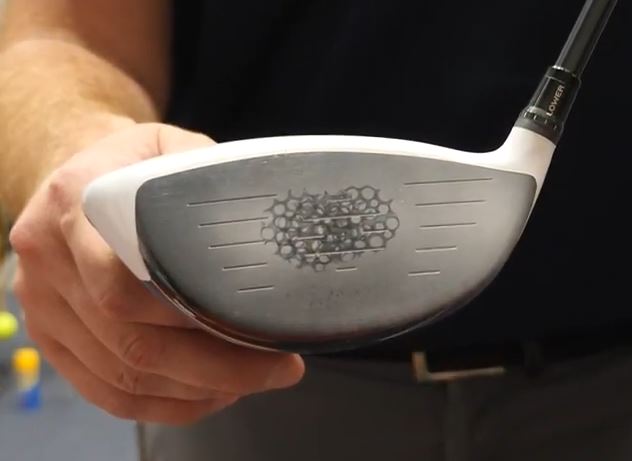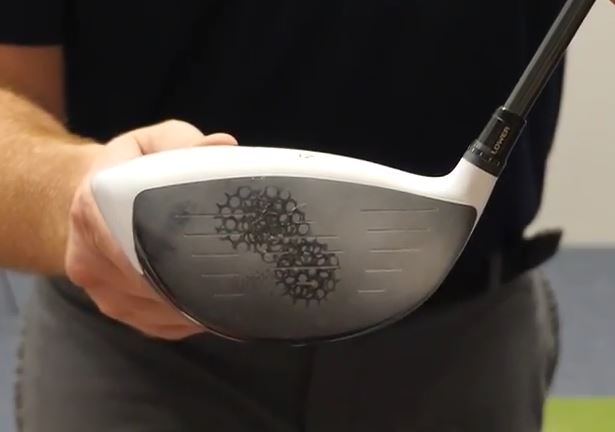
The Moment of Inertia in your swing is effectively how much force your clubhead has at impact.
In truth, the Moment of Inertia (MOI) is a dynamic number that is constantly changing and technically refers to the amount of force required to alter the speed or direction of your clubhead, but for practical purposes, the only MOI that matters is the MOI at the moment of impact.
MOI is calculated using the mass and speed of the object.
Assuming a centered strike… If you want to hit the ball farther, you have to increase the mass or increase the speed of the clubhead.
It’s important to note that the shaft, grip, your body, etc. don’t matter in the calculations of the Moment of Inertia. The ball reacts with your clubhead for such a short period of time that it’s not even aware of the shaft, let alone the grip, your hands, arms, or body. As the ball strikes the club, it sends a wave of pressure through the clubhead, but the ball is already gone before that wave reaches the shaft of the club, let alone reflects and comes back to amplify anything.
This isn’t to say that your body, arms, hands, grip, and shaft aren’t important… all of these are how you accelerate a club into impact and manage the club after impact… but they don’t have any effect on the MOI at the moment of impact. In fact, in some cases, for a large clubhead, the entire clubhead isn’t even calculated in the MOI because the outer edges don’t have any effect on the impact.
Back to hitting the ball farther… you have to increase the clubhead mass, increase the clubhead speed, or both.
In human tests, as you increase mass, you lose speed… and any benefits are almost exactly neutralized. Alternatively, if you decrease mass, you increase speed… again imparting the same amount of force on a golf ball.
We humans are insanely complex and efficient machines. It seems the amount of power we generate with a club is effectively static.
The late great Moe Norman, arguably the most consistent ball striker ever, used to put on an exhibition with brand new drivers from all the major club manufacturers. He’d hit a few balls with each driver and when he was done, ALL of the balls were within a few feet of each other, regardless of the club.
For sure, there are illegal shafts like the AutoFlex that are designed to increase your clubhead speed, but given standard [legal] equipment, your force is a set number.
Why do golf club manufacturers spend millions in R&D on club design? To make off-center strikes still fly straight and far.
By changing the design and properties of the face of the clubhead, you can manipulate the pressure wave and reflections of that pressure wave so that, hopefully, the ball still flies straight, even when you don’t hit the center of the club. Which is also why one club might perform better for you than another… if you’re not Moe Norman and able to hit the ball on the head of a pin every time.
To hit the ball farther, you have to increase your MOI, the force you hit a ball with.
If your force is basically a set number… how do you hit the ball farther?
You have to get stronger AND faster.
Your force is only a set number for your current physical condition. If you get stronger and faster, you’ll be able to impart more force on a golf ball.
A lot of products encourage overload training for strength and underload training for speed. Effectively, a heavy, weighted shaft and a light, unweighted shaft.
Overload and underload training do work… but like going to the gym, it takes months and even years to get the results you want.
The problem with overload and underload training is gravity. The radically different swing weights have the undesirable effect of pulling on your body in a way that disconnects your arms from your body.
Connection and Rotation are the keys to speed in a golf swing.
Your arms are strong, but your legs, hips, and core will always have far more strength than your arms. Even if you look like Lou Ferrigno and can bench press your body weight… If that’s you… you can probably also dead lift a small SUV.
The arms don’t push the clubhead through a golf ball, they act as a fulcrum in the rotation and acceleration of a club. Their job is to be strong enough to let the club rotate around them, not drive the club directly.
This is where the design of the Prolete is extremely unique.
The Prolete connects the shaft of your club to the patent pending Power Guide about your waist with a resistance band. Because the resistance band weighs almost nothing, it doesn’t change the swing weight or gravitational pull on your club. In fact, as you swing a club, the Prolete actually helps keep you connected.
The Power Guide allows you to take a full swing and provides dynamic resistance throughout your full swing.
- At address, the Prolete pulls you in, forcing you to create structure with your arms.
- In your backswing, the Prolete pulls you down and in, forcing you to maintain your structure, increasing the width and elevation in your backswing.
- In transition, the Prolete helps you get the clubhead on plane by letting you feel the club shallow.
- Through impact, the Prolete pulls the clubhead back, forcing you to activate the hands and arms as a fulcrum.
- In your finish, the Prolete pulls down, forcing you to maintain structure and finish high.
The Prolete is a better forearm workout than anything you can do in the gym. It keeps you connected and improves your rotation.
PLUS… the Prolete lets you swing your own clubs while hitting real golf balls.
You get stronger AND faster just by hitting balls into a net in the backyard.
AND… through the magic of resistance band training, which increases results 3x by activating the fascia (all the connective tissue in your body), you’ll see immediate results with full results in days or weeks, not months and years.
There didn’t used to be a way to train your MOI. You used to have to get stronger and faster and more flexible… and then hope that it resulted in more distance. With Prolete, you can actually train your MOI and get near instant results.
Click Here to Learn more about the Prolete Golf Swing Trainer »
Hitting the ball down has nothing to do with bat path.
Hitting down means making contact with the top hemisphere of the ball.
Hitting up means making contact with the bottom hemisphere of the ball.
Line drives are centered contact.
You will transfer the most power into a line drive because more of your energy is converted to speed.
When you hit up or down, some of your energy is converted to spin. (This is actually a good thing.)
For grounders and dingers, spin is good. For a ground ball, a little top spin makes it harder to field the ball because it “hops.”
For a dinger, a little backspin actually helps the ball float and stay in the air longer, letting it fly farther.
“Shortest path between two points is a straight line… Throw your hands straight to the ball.”
The shortest DISTANCE between two points is a straight line… HOWEVER, in physics, the shortest TIME between two points is achieved by following the Brachistochrone [bruh-kis-tuh-krohn] Curve.
This curve is the fastest time from loaded to contact, which is also the fastest bat speed.
The straight line is the shortest distance but it is the SLOWEST time to contact and the SLOWEST bat speed.
Your driveway may be short, but you can’t hit top speed in your Ferrari in a driveway.
The smaller the whip, the harder to crack. The longer the whip the easier it is to crack.
A little longer bat path lets you speed up your bat effortlessly.
If you’re looking to increase your exit velocity, you should start with your bat path.
Your bat path matters…
*SPOILER ALERT* The fastest path between two points is NOT a straight line.
There are 3 common bat paths…
- Direct Line – Taught by most coaches.
- On-Plane Early – New Age / Ken Griffey Jr. swing.
- Uppercut / Golf Swing – Most coaches hate seeing this.
The Direct Line swing is what most coaches teach. If your hands start by your ear, thye move in a direct line from your ear to the ball. It’s a “chop” style motion similar to swinging an ax. This move is taught by most baseball and softball coaches at all levels.
Coaches HATE looking at the Uppercut / Golf Swing. It looks like the bat drops behind you and as you rotate you have to swing up at the ball. Many well meaning coaches even tell their players they shouldn’t play golf if they want to be good at baseball.
The On-Plane Early swing is actually the fastest swing… with the ideal attack angle.
In Math and Physics, the On-Plane Early path is called the Brachistochrone [bruh-kis-tuh-krohn] curve, which comes from the Greek translation for “Fastest Time”.
The Direct Line, what almost everyone teaches, is actually the SLOWEST with the LEAST chance to barrel it up.
Surprisingly for most… the Uppercut / Golf Swing is actually MUCH closer to a good swing than the Direct Line.
You can see in the video below Adam Savage from MythBusters demonstrates the three common bat paths.






